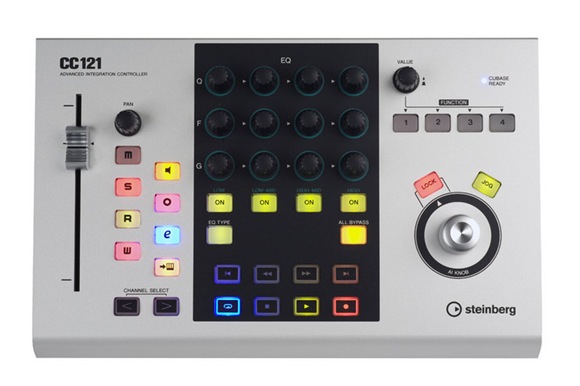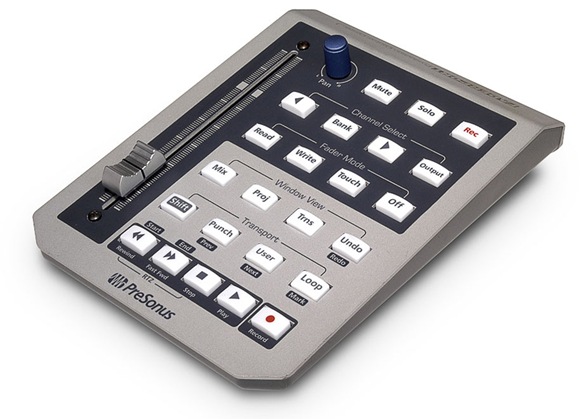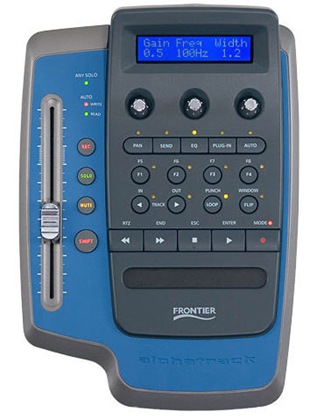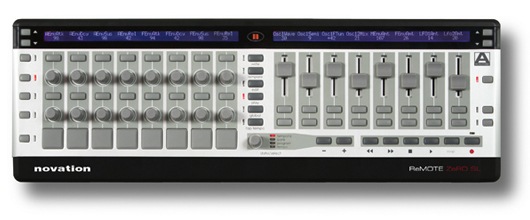This is the new Steinberg control surface. (See the hands-on video at SonicState.) It’s built to integrate out of the box with Cubase 4, which if you’re a Cubase 4 user should be good. You or I might give it a name like “CubaseControl” or something, but Steinberg has seen fit to call it the CC 121, which sounds like it was lifted off of a MIDI specification. No matter — they can call it Eustice if it’s a good controller.

But that’s not the only odd thing about the CC 121. There’s a little light that goes on to say it’s “Cubase Ready.” (The marketing materials say this gives it “instant plug and play.” I’m not entirely sure why you need an LED for that, but I guess it’s comforting or something.) Then there’s the control layout, which has so much blank space that it looks a little like someone dropped a stack of encoders and buttons on a piece of paper and glued everything where it fell.
But the oddest thing about the CC 121 is the controller choices themselves. The whole point of previous single-fader control surfaces — at least, so I thought — was creating a compact device that can sit by your mouse. The point of the CC 121 seems to be, well, EQ. There are a full twelve dedicated EQ encoders. For everything else, there’s … uh … one knob. (It’s the one that says “VALUE” on the right side.) It is supposed to be a really smart knob, at least. Here’s how Steinberg describes it:
“Ultra-precision Advanced Integration controller knob with ‘point and control’ support: controls any visual Cubase 4 parameter, internal FX setting or VSTi parameter using mouse pointer selection”
Translation: you can click on any setting in Cubase and control it with our encoder, one setting at a time. Want to control more than one setting at a time? Say, delay time and wet/dry mix? Sorry. There are four buttons so you can change the function of the one value knob, but not the obvious solution of having any more than one knob. I know what you’re thinking. There’s blank space all over this unit, so why couldn’t you just have four “Advanced Integration Controller Knobs”? I think I have the answer: if you did that, you wouldn’t have room for the “Cubase Ready” light.
You may think I’m just using this opportunity to beat up on Steinberg and be snarky, but I’m not.
The Magic of Third Parties and Broad Compatibility
No, on the contrary, this illustrates something I’ve suspected for a long time. Just as most screenwriters shouldn’t direct their own films, software developers shouldn’t necessarily make hardware controllers for their own software. Sometimes the magic works; sometimes it doesn’t. Either way, having choices beyond those the software vendor chose is a good thing. Third-party hardware can work with more than one app (in case you ever use something other than Cubase), it can provide more choices (in case your needs are different than someone else), and it provides the much-needed perspective beyond the folks who built the software. You may not get the brand name of your DAW on the unit, but smart software can still make the out-of-box experience just as integrated. That doesn’t mean I think the software vendors shouldn’t try — as Alan Kay is often attributed as saying, “People who are really serious about software should make their own hardware.” But, even assuming he did actually say that, and assuming we should all listen to him, he didn’t say that you had to make that hardware for your own software, or that you’d be successful all of the time.
Someone out there I’m sure really, really loves tweaking EQ. Congratulations: the CC 121 is for you. For everyone else, you have not one but four excellent choices: Novation’s SL line, Frontier’s AlphaTrack and TranzPort, and PreSonus’ FaderPort. They all integrate fairly automatically with Cubase (even older versions which are incompatible with the CC 121), and give you lots of control. And that’s just compact control surfaces.
Not only that, but Novation, Frontier, and PreSonus all make hardware that works with other stuff not from Steinberg. The AlphaTrack, for instance, just added extensive support for GarageBand 4 (adding to a long list of other supported software), plus software you probably haven’t even heard of — SAWStudio by RML Labs and MultitrackStudio from Bremmers Audio Design. SAWStudio support didn’t grab the Messe headlines the way a Steinberg control surface did, but I’ll bet if you’re a SAWStudio user, you’re really excited. And that’s the point: we choose our software personally, so we should choose our hardware the same way.
Here’s a quick review of the other compact control surfaces available — not only for Cubase, but a lot of other software, as well:

The PreSonus FaderPort does a lot less than the new Steinberg piece — but it also takes up a fraction of the space, meaning you could put this right by your mouse and keyboard and put a full-sized control surface somewhere else if you like. And it has a dedicated punch button, which it looks like the Steinberg unit may actually lack. (I hope I’m wrong about that.)
Works with: Cubase SX 3 / Nuendo 2, SONAR 5, DP 4, Pro Tools 6, Logic Pro 7/8, Logic Express 7 and later versions of each of those. (So, ironically, if you’re a Cubase user who hasn’t upgraded from version 3, you want this instead of the Steinberg-branded unit.)

The Frontier AlphaTrack is currently my favorite one-fader piece, for three simple reasons: it’s got knobs and a ribbon for more control, it has a screen so you can see what you’re doing, and it works with Ableton Live. That easily makes it worth sacrificing some additional space to me. Meanwhile, while you can click stuff and control it with the Steinberg unit, the Frontier has dedicated buttons for its EQ, plug-in modes, and so on, so you don’t have to click at all.
Frontier also makes a wireless unit called the Tranzport — no fader, but jog, shuttle, and key record buttons, plus a screen. It works with a huge array of software (even FL Studio), and since it’s wireless can be ideal for using when you’re recording.
Works with: Audition, Logic, Cubase, DP, Live, Final Cut, Guitar Tracks Pro, Nuendo, Pro Tools, REAPER, Reason, SONAR, Soundtrack Pro, Tracktion, GarageBand, and now SAWStudio and MultitrackStudio, and maybe more by the time you’re reading this.

It’s got quite a lot more than one fader, but the ReMOTE ZeRO SL (and the rest of the SL line) is worth a mention here, because a) it’s relatively compact (if bigger than the other options here) and b) it can automatically map to software parameters and plug-ins in the software. Like the Frontier, there’s a screen, which means you can use this without being glued to your computer monitor — or, via a new update, you can get even oversized screen feedback that you don’t have to squint at. It lacks a jog wheel, and the faders aren’t motorized and have a throw that’s too short for extended use. But for plug-in tweaking, it wins handily — and aren’t a lot of Cubase users VST nuts, anyway? (As I was saying, the point isn’t One Control Surface To Rule Them All, it’s One Control Surface That Fits You.)
Works with: Via Automap Universal, Pro Tools, Logic, DP, Ableton — and, yes, Cubase and Nuendo
What Will You Use?
With all of those choices, you can see one reason why you might get the Steinberg unit when it comes out: the jog wheel is nice. But you have a much broader array of choices. Heck, if you really like that Steinberg logo, print it out and tape it to your unit of choice.
Are you a Cubase user? Is the CC 121 what you want? What are you using to control your DAW of choice? Let us know in comments.